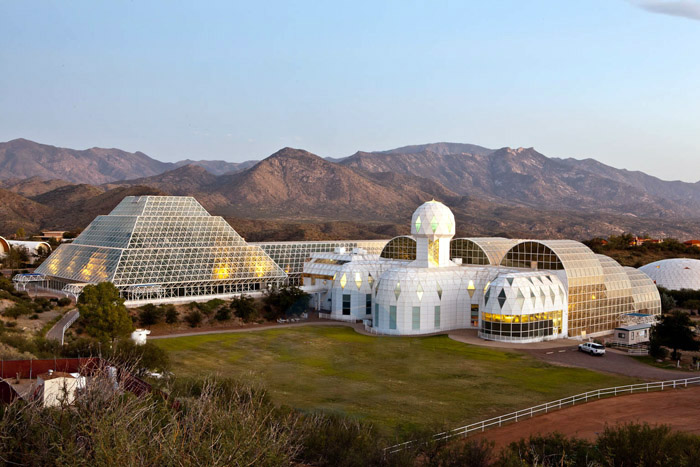In 1897, southern England was invaded by Martians. Or rather that was the plot of H. G. Wells's now-classic novel The War of the Worlds. Those of us on Earth have long been fascinated by what we might find on the red planet. Could humans travel there and survive? This month, historian Lisa Rand Ruth charts the decades of experiments here on Earth to prepare for a voyage to Mars.
On September 29, 2017, SpaceX CEO Elon Musk took the stage at the 68th International Astronautical Congress in Adelaide, Australia. Musk spoke about his company's plans for interplanetary travel and his belief in humanity's future as a multi-planet species.
His proposed first stop: Mars—sooner and cheaper than might be expected. In front of the assembled international audience of space enthusiasts and industry leaders, Musk boldly announced that SpaceX would reach the red planet by 2022.
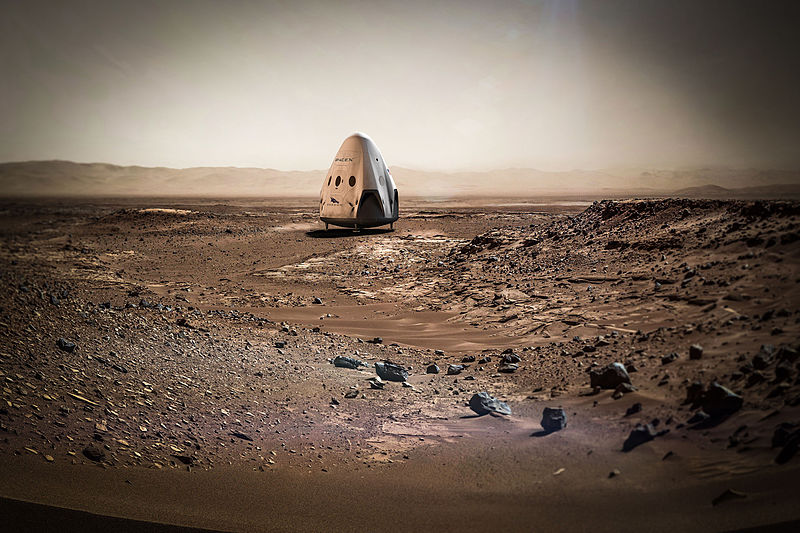
Concept art for a SpaceX spacecraft on Mars.
This was not the first time the technology entrepreneur had made such bold pronouncements in front of the IAC crowd.
A year earlier, at the 67th IAC meeting in Guadalajara, Mexico, Musk had revealed that he had built his vast business empire primarily in order to make colonization of other planets possible, and presented a compelling plan for how to get to Mars. His glimmering visions of a terraformed planet, clean, orderly Martian settlements, and low estimated ticket price stoked his audience’s breathless desire to venture into the cosmos.
However, in addressing questions from the audience, Musk evaded practical questions such as who ought to make the dangerous first trips and how he expected to handle the problem of human waste. His focus on innovation reflects a current surge in enthusiasm for triumphant technological solutions to local- and global-scale problems and a longstanding disdain for the mundane and messy.
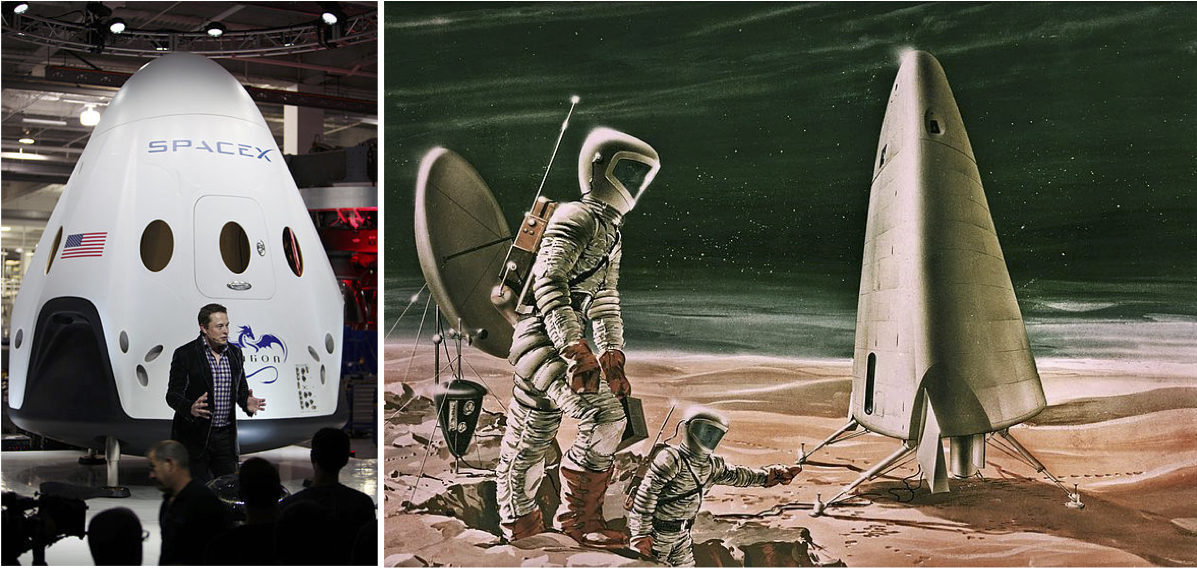
Elon Musk unveiled the Dragon V2, a spacecraft designed to carry people into Earth’s orbit and developed through a SpaceX and NASA partnership, in 2014 (left). Concept art for the Mars Excursion Module in a 1964 NASA proposal (right).
Nearly half a century has passed since human feet last touched the surface of another celestial body. In the time since astronaut Eugene Cernan’s final steps on the Moon, we’ve sent uncrewed spacecraft near and far—to planets, moons, asteroids, comets, and dwarf planets, even to the very edges of the solar system. Human explorers, however, haven’t ventured beyond low-Earth orbit since 1972.
That hasn’t stopped dreamers and the practical-minded alike from contemplating what our next steps into the mythical final frontier should be.
As our closest neighbor and host to a bevy of robotic spacecraft that have gone before, Mars is a popular destination among those who yearn to make new footprints on an untrammeled world. Even before the Moon became the established finish line of the Cold War Space Race, leaders of the American and Soviet space programs envisioned Mars as humankind’s first stop in exploring the cosmos.
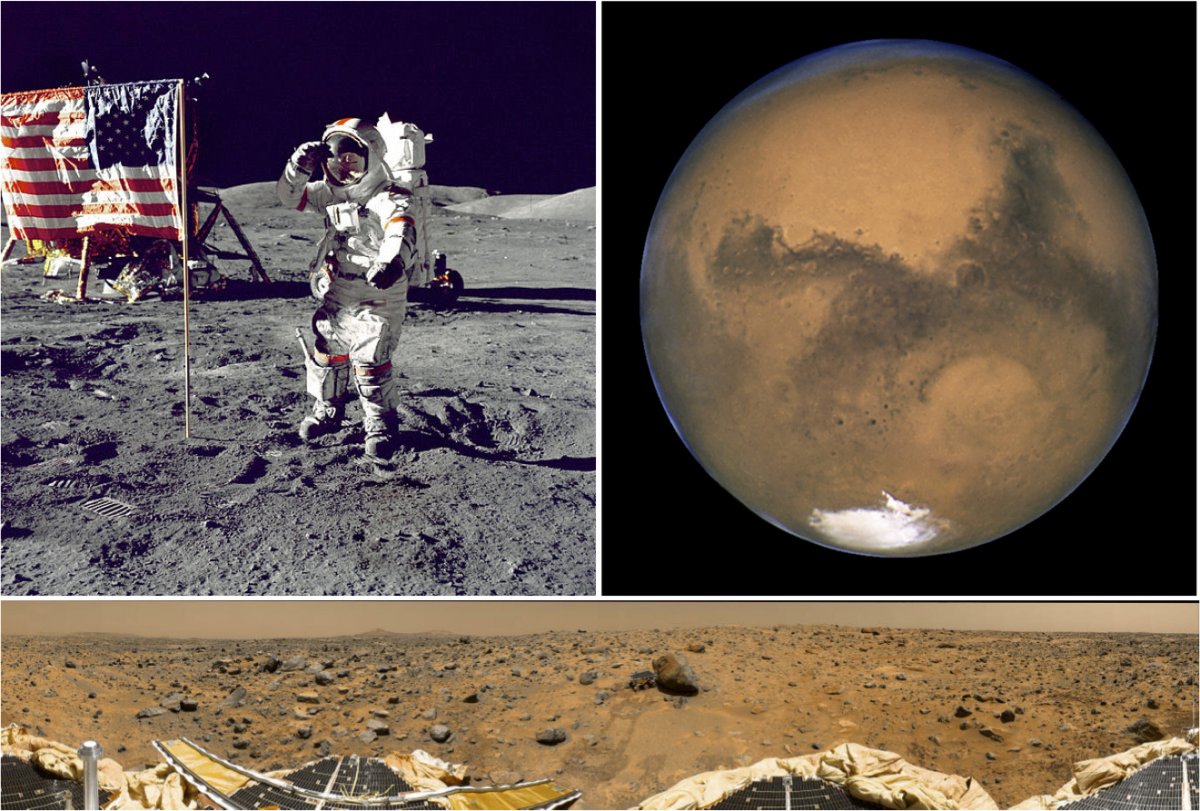
Astronaut Eugene A. Cernan on the moon in 1972 (left). Mars in 2003, when it was only 34,647,420 miles from Earth—the closest the two planets have been in 60,000 years (right). A panoramic image of the Mars Pathfinder mission taken from its landing site in 1997 (bottom).
U.S. federal plans for planetary exploration have waxed and waned since the days of NASA’s Project Apollo, during which American men traveled to the moon and back nine times from 1963-1972. Following legislative wrangling over the proposed Asteroid Return Mission during the Obama administration, Donald Trump resuscitated George W. Bush’s promise to return to the Moon and move on to Mars—and like his predecessor, he did not offer concrete plans for doing so.
However, with the rise of a thriving private space industry, presidents and legislators no longer hold exclusive authority over extraterrestrial planning. Tech billionaires, aging Apollo astronauts, and nonprofit space enthusiast foundations have lately emerged as practical power players.
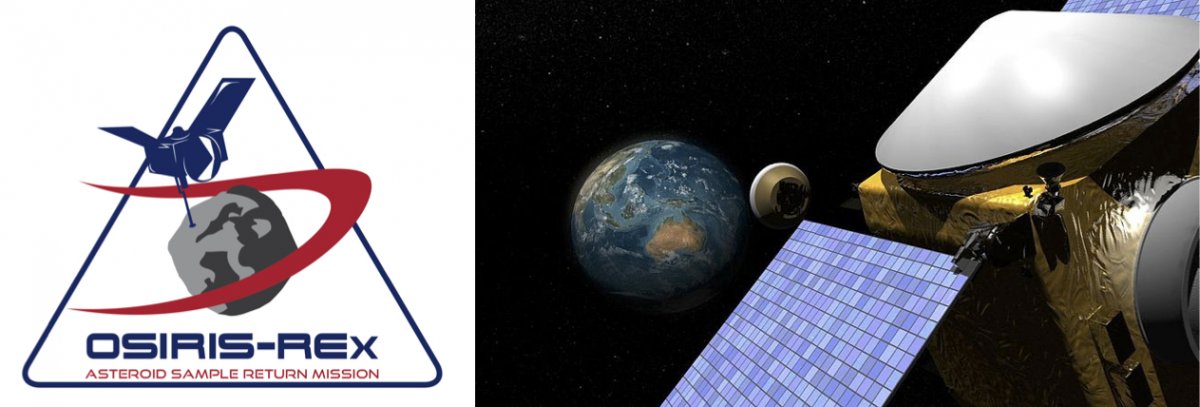
The 2015 mission logo for the OSIRIS-REx mission (left). Concept art for the OSIRIS-REx Capsule returning to Earth (right).
Musk and Blue Origin CEO Jeff Bezos have both declared Mars a target for their burgeoning aerospace businesses. In 2015, the nonprofit Interplanetary Society successfully launched a citizen-funded propulsion system that uses solar energy as a kind of cosmic sail. Enthusiast organizations from the Mars Society to Apollo 11 astronaut Buzz Aldrin’s ShareSpace Foundation all promise that with a little imagination—and money—humans will reach Mars within the next few decades.
While the thrill of exploration yielded “flags and footprints (PDF File)” on the Moon, it takes more than a few small steps to turn a frontier into a colony. If humanity is to become a truly multi-planet species, we must develop both the will and the means to go and to stay put.
Getting there is only the first challenge. Figuring out what to do once humans arrive is much harder.
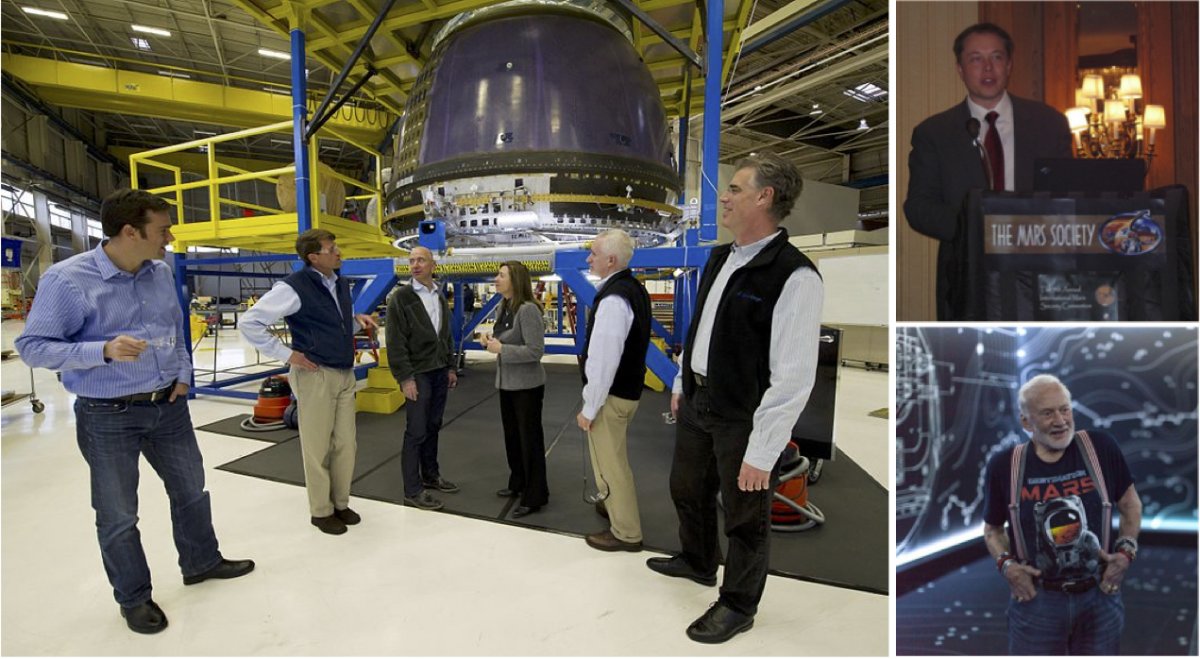
Jeff Bezos (third from left), the Founder of Blue Origin, and Lori Garver (forth from left), NASA Deputy Administrator, in front of a composite pressure vehicle at the Blue Origin headquarters in 2011 (left). Elon Musk speaking at a Mars Society Conference in 2006 about the Falcon 9 launch vehicle and Dragon manned spacecraft (top). Apollo 11 Astronaut Buzz Aldrin in 2016 at a preview of the Kennedy Space Center Visitor Complex exhibit on Mars (bottom).
Mars as Empire and Utopia
The yearning to homestead other worlds isn’t anything new. The same desires that motivated European imperial pursuits and Anglo-American westward expansion in centuries past underpin many 20th-century arguments for extraterrestrial empire on the “final frontier.” Innumerable novels and movies feed a mainstream audience hungry for imaginary scenarios in which humans travel to other planets, and wonder what we might do once we get there.
In books and films, tales of tragic conquest are as common as fantasies of brighter futures in which humanity corrects the wrongs committed on Earth. Writers including Ray Bradbury and Sun Ra have even imagined radical futures of racial justice through the establishment of extraterrestrial black communities. Space is the place where the righteous of humanity may build new utopias and leave behind a ruined Earth.

Ray Bradbury’s The Martian Chronicles (1950) is collection of science fiction short stories about the colonization of Mars by humans fleeing an environmentally devastated Earth and coming into conflict with aboriginal Martians (left). The film poster for Sun Ra's Afrofuturist science fiction film, Space Is The Place (1974), (right).
During the late 19th century, astronomer Percival Lowell studied Mars from his observatory near Flagstaff, Arizona. He concluded that intelligent creatures had constructed canals to carry water across the surface of Mars, an idea that remained popular until 1965 when the first photographs from the Mariner 4 probe revealed a waterless, lifeless planet.
In subsequent decades, robotic orbiters, landers, and rovers have mapped the surface of the planet, conducted remote experiments, and even taken famous, red-tinged selfies. A fleet of spacecraft have successfully made the journey, from the twin Viking landers of 1976 to the ExoMars Trace Gas Orbiter that reached Martian orbit in October 2016.
Each spacecraft has been designed to protect the planet from being “seeded” with Earth microorganisms. Data from these missions have led scientists to determine that, while no life appears to exist on Mars, abundant water does.
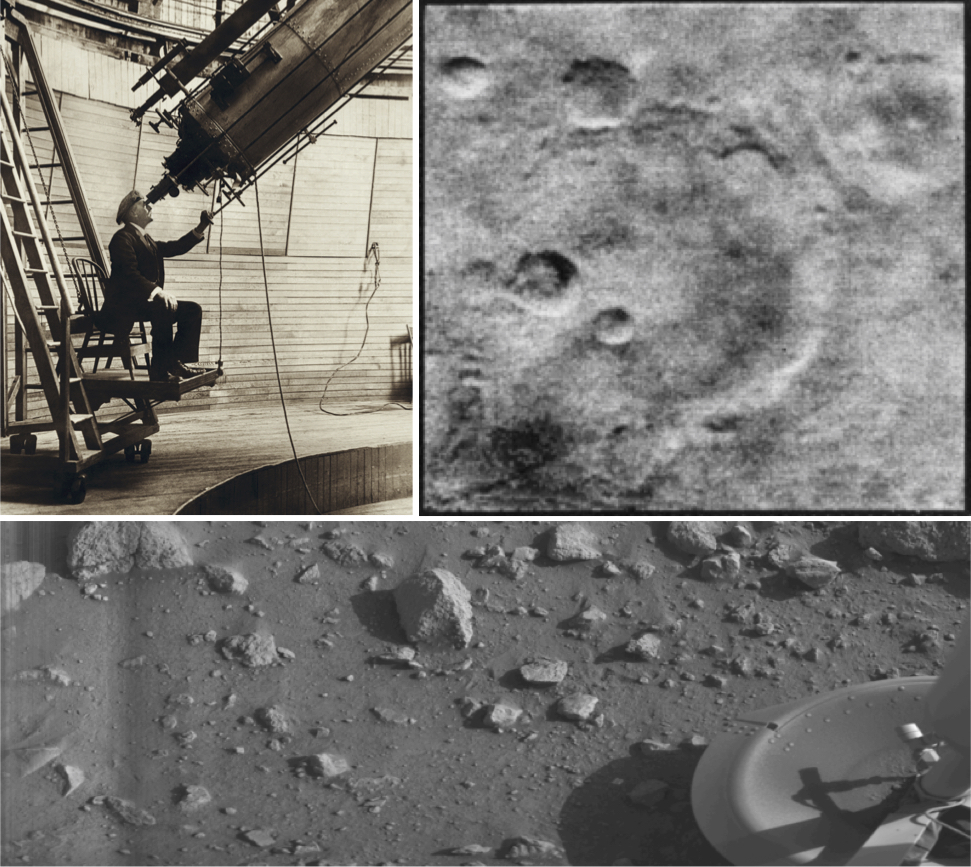
Astronomer Percival Lowell at his Flagstaff, AZ observatory in 1914 (left). A photograph of craters on Mars taken by Mariner 4 in 1965 (right). The first “clear” image transmitted from the surface of Mars by Viking 1 in 1976 (bottom).
Perhaps this very lifelessness has made Mars that much more appealing to would-be colonizers. With no living creatures to be subjugated, moral questions about taking over an entire world seem less fraught than if living, breathing Martians existed.
Indeed, ecologists and environmentalists of the 1960s and 1970s enthusiastically studied extraterrestrial colonization largely because of this apparent lack of moral ambiguity.
During this time, as astronauts prepared to take the first steps on the Moon and environmental movements gained steam around the world, scientists like Edward Wilson and Eugene and Howard Odum considered whether more orderly worlds might be created on other planets. NASA even funded studies by ecologists to determine how to build self-sustaining “life boats” in orbit as a stepping stone to extraterrestrial colonization.
Leaders in current space culture express their desire for permanent colonization of other planets either to escape a dying earth or as a means to improve life on earth.
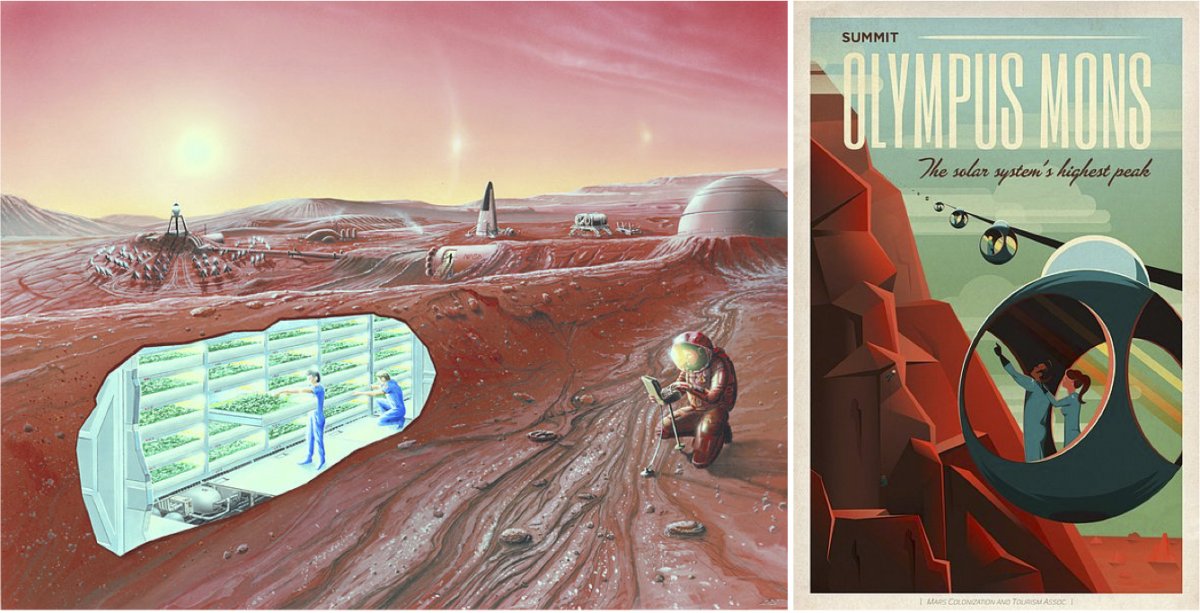
Concept art for a Mars settlement with a cutaway view of an underground habitat area for growing food (left). A fictional Mars tourism poster commissioned by SpaceX in 2015 (right).
Some, like Musk, see colonies on Mars as the only way to ensure the survival of life as we know it. Their worry is growing as the physical evidence of climate change continues to mount and American political will fails to rise to the challenge.
NASA Administrator Charles Bolden has also advocated interplanetary colonization but with a more distant doom in mind—noting that our Sun will eventually transform into a red giant star whose radius will consume Earth, Bolden argued that homo sapiens must become a multi-planet species to ensure its long-term survival.
Others, like Jeff Bezos, sees otherworldly colonies as sources for energy and raw materials to bolster Earth civilizations—a colonial vision in lockstep with imperial programs throughout history.
Buzz Aldrin sees permanent colonization as the only way to make scientific research on other planets affordable and sustainable—a perspective he likely gained after his 2.5 hours traversing the lunar surface in 1969.

NASA Administrator Charles Bolden speaking to students in 2016 (left). Astronaut Buzz Aldrin during a lunar landing mission in 1969 (middle). Bolden congratulating SpaceX CEO Elon Musk after the first successful mission by a private company to carry supplies to the International Space Station in 2012 (right).
Planetary Analogs from Moon to Mars
As Aldrin knows, even getting off the planet requires immense investment of resources, capital, technology, and intellect. And expenditures by the federal government to support space travel seemed more plausible during the Cold War era than they do today.
Surviving for long periods on another world has yet to be attempted. It goes without saying that living any place other than the planet to which the human species has been perfectly adapted presents monumental difficulties beyond securing funding.
Cold War-era thinkers began to work out the challenges of extraterrestrial living before making the voyage. Several organizations took on the task of making Earth like Mars—creating what are known as planetary analog habitats.
Planetary analogs involve recreating the conditions of another celestial body on Earth. This has historically involved working in an ecosystem resembling the Martian landscape, building habitats that replicate the expected conditions of extraterrestrial living, and determining what parts of Earth might best survive and sustain life on another planet.
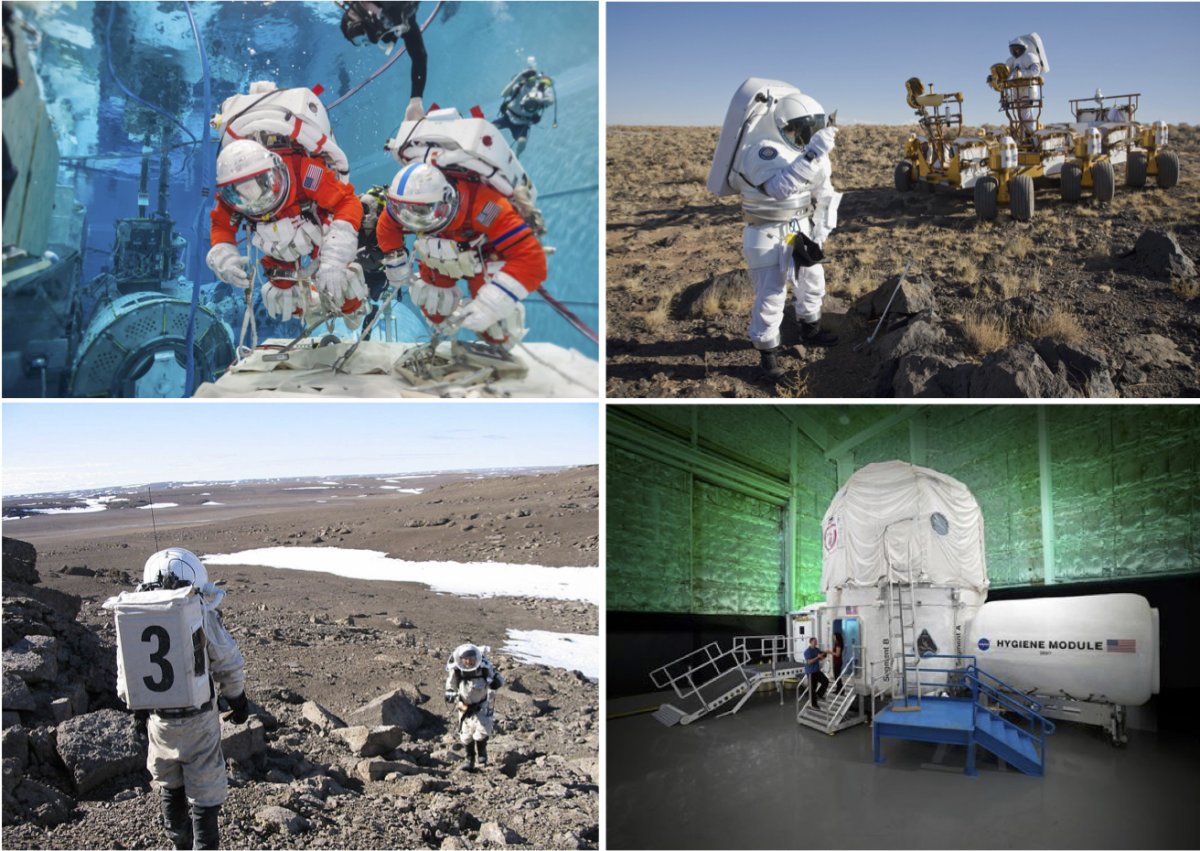
Astronauts practicing microgravity techniques in NASA’s Neutral Buoyancy Lab at Johnson Space Center (top left). An astronaut and geologist in Arizona testing a lunar rover in 2008 as part of the Desert Research and Technology Studies program (top right). Members of the Mars Research Society practice near the Flashline Mars Arctic Research Station in 2001 (bottom left). The Human Exploration Research Analog at the Johnson Space Center in Texas is a modular, three-story habitat designed to simulate the isolation, confinement, and remote conditions of mission exploration scenarios (bottom right).
Planetary analogs provide the opportunity to test out humans’ adaptability without having to leave the safety of planet Earth. These experimental attempts have ranged from geological training exercises to constructing large-scale Earth habitats. With each planetary analog experiment, the imagined realities of life on another planet shifted in place.
Will future “Martians” wear space suits and move from tiny habitat to tiny habitat? Will they be expected to tend entire ecosystems? Or will they oversee the wholesale transformation of an entire planet to mimic the familiar Earth?
Some of the first planetary analog experiments were designed to simulate what geologists expected astronauts might find upon landing on the Moon. NASA selected natural sites that resembled what the Moon looked like from afar. Astronauts trained at sites in New Mexico, Nevada, Alaska, Hawaii, and Iceland, each chosen for their strange geological features.
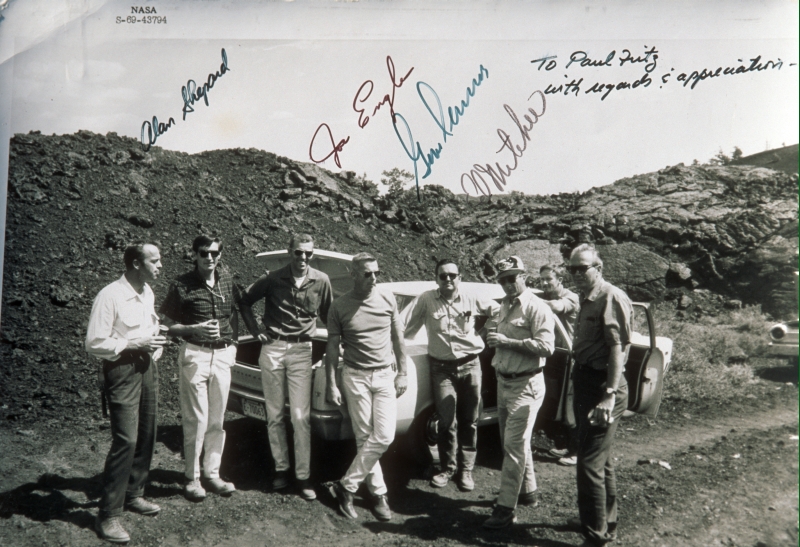
Members of the Apollo-14 team at the Craters of the Moon National Monument in Idaho in 1969.
During the mid-to-late 1960s, popular attractions such as the Grand Canyon, Sunset Crater, and Meteor Crater—not far from the Arizona observatory where Percival Lowell once studied Martian canals—provided geologists with opportunities to teach non-scientist astronauts how to evaluate rock strata in the field.
The aptly named Craters of the Moon National Monument in Idaho served as a useful site for astronauts to practice maneuvering and using new tools. The monument continues to be used as a test bed by planetary scientists.

Where naturally occurring rocky features would not suit training needs, federal scientists made new ones. In 1967, the joint NASA-U.S. Geological Survey Astrogeology Research Program built a microcosm of the Moon into the rocky terrain of an extinct Arizona volcano by blasting holes in the ground to resemble lunar craters.
Astronauts wore space suits, collected soil samples, and drove a lunar module nicknamed “Grover” through the artificial moonscape that came to be known as the Cinder Lake crater field. Such analog sites allowed astronauts to practice a few small steps in a place that resembled the Moon before taking the 238,000-mile voyage.
As human planetary exploration waned after Apollo ended in 1972, robotic emissaries required similar sites on Earth to anticipate and practice maneuvering in places like the Martian landscape. Desert ecosystems have long provided useful “sandbox” trials for rovers.
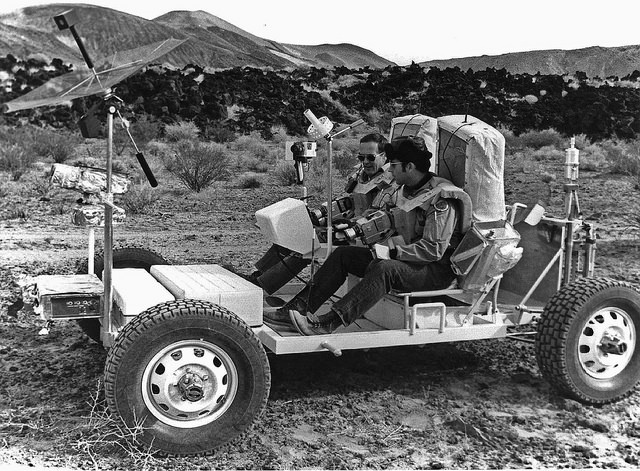
NASA and the U.S. Geological Survey Astrology Research Program testing equipment in Nevada in 1972.
In addition to testing mechanical systems, Earthly analogs provided useful settings to drum up popular support for Mars missions. To celebrate the Viking landers’ trips to Mars, landing a few months apart in July and September of 1976, famous science popularizer Carl Sagan posed with a Viking model in Death Valley. The reddish hued sands and alien geological formations suggested what Viking might look like once it reached its destination.
These analogs rendered Mars more familiar to non-planetary scientists. When the Viking landers sent back their images, the landscape looked uncannily familiar, much like the deserts back home.
The Soviet and Russian space programs have notoriously found it difficult to complete successful missions to Mars. Each attempt since 1960 has failed.
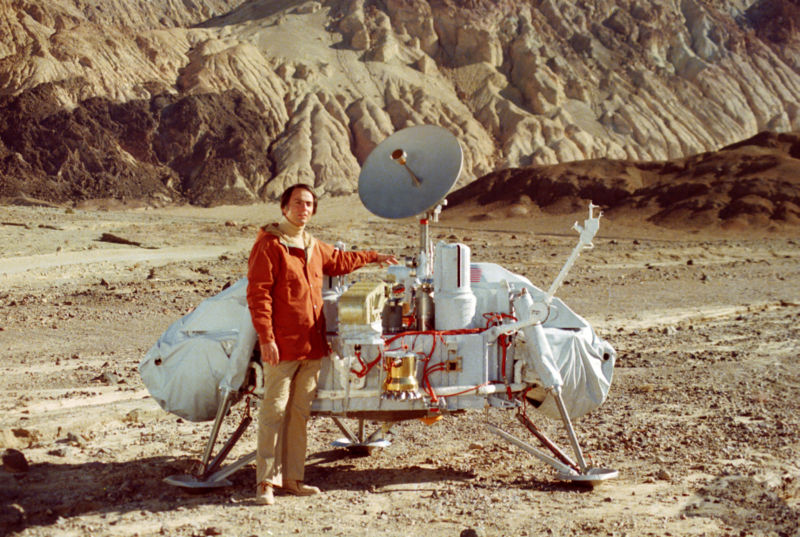
However, while the United States successfully launched and landed Viking spacecraft on Mars, the Soviet Union developed and tested closed life-support systems intended for future use by cosmonauts on other planets.
The Soviet BIOS program ran from 1965 with the construction of BIOS-1 through the mid-1980s with the operation of the BIOS-3 facility. With each subsequent BIOS structure, Soviet scientists increased the complexity of plant life used to exchange gasses with human occupants. The earliest experiments used algae, and later tests employed specialized growth chambers to cultivate vegetables such as wheat, beets, carrots, cucumbers, and dill.
BIOS-3 was constructed entirely underground in Krasnoyarsk, Russia, and supported its first fully enclosed human crew of two men and one woman in the winter of 1972 to 1973. Missions ranged in length from several months to a year. Researchers claimed that the BIOS project demonstrated that a habitat could successfully use food crops and other plants to uphold the exchange of oxygen and carbon dioxide necessary to keep human occupants alive in a closed system—the kind that would be necessary for a mission to Mars.

A mission patch for the Soviet Vostok 3 program in 1962 (left). The first American female astronaut, Sally Ride, aboard the Challenger Space Shuttle in 1983 (right).
Meanwhile, NASA continued to reach for human trips to Mars. Following the Challenger disaster in 1986, NASA recruited a committee chaired by Sally Ride, the first female astronaut, to contemplate ways to revive and refocus the American civilian space program. In addition to bolstering the shuttle program, continuing the space station project, revisiting the Moon, and supporting ongoing robotic exploration of the solar system, the Ride Report called for establishing an outpost on Mars.
Three years later, on the 20th anniversary of the Apollo 11 moon landing, President George H. W. Bush revealed his Space Exploration Initiative, which also promoted a return to the Moon and Mars.
These perennial calls for Mars colonization did not go into detail on the methods and plans for long-term settlement. None moved beyond initial grand announcements. Even our robotic emissaries stayed home—two decades elapsed between the Viking landings and the 1996 launch of the Mars Pathfinder mission. For 20 years, humankind steered clear of the red planet.

The Biosphere 2: An Ecological Dress Rehearsal
As NASA committees and American presidents contemplated grand visions of extraterrestrial travel without much in the way of action, one of the most prominent attempts to simulate a Martian homestead was accomplished by a group pursuing extraterrestrial utopia. Rather than practicing colonization in a place on Earth that resembled Mars, this collective staged a dress rehearsal by crafting a tiny Earth on Earth.
A collection of self-trained ecologists, architects, and artists toiled from 1987 to 1991 to build the enormous, closed-system greenhouse that came to be known as the Biosphere 2—Biosphere 1 being planet Earth.

Biosphere 2 in 1998 near Tucson, AZ.
In its early years, the facility operated outside the auspices of NASA, the military, or even an established research institution. Unlike the BIOS researchers, Biosphere 2 did not benefit from state money. In the middle of the Arizona desert, a private patron funded an effort by concerned, eco-minded citizens to test whether Earth in microcosm could survive in a place like Mars.
The designers of Biosphere 2 presented it as many things—an ecological laboratory, an organic lifeboat, and a prototype for an extraterrestrial analog habitat. Oil heir Edward Bass provided some $150 million to the group of performance artists and self-trained ecologists based at the Synergia Ranch in New Mexico to build and operate the facility.
Publicity materials represented the ambitious project as a test run for recreating small Earths—either on places like Mars or on Earth itself to act as a self-sustaining lifeboat in the event of ecological collapse. The primary goal: to enclose humans inside the small Earth and determine whether such a system could sustain life over long periods of time.

The Savanna (foreground) and Ocean (background) of Biosphere 2 in 2003 (left). The living quarters for the inhabitants of Biosphere 2 (middle). The Coastal Fog Desert section of Biosphere 2 in 2005 (right).
The Biosphere 2 designers traveled far and wide to study and construct the ecosystems included in the greenhouse. Synergia participants even transported coral reef organisms from the Caribbean to the Biosphere 2 ocean—a remarkable feat given the fragility of such organisms and their inability to thrive in captivity.
By the time the facility was pronounced ready for the first fully closed, self-sustaining “mission,” some 3,800 different species populated seven biomes, representing the ocean, a rainforest, a wetlands, a savannah, a fog desert, an agricultural area, and a human habitat.
In September 1991, a crew of eight “biospherians” wearing dark blue flight suits paraded past cheering crowds before walking through the airlock of the facility. With the exception of a medical emergency requiring the brief exit and return of one crew member, they would not emerge for two years.
Much like real astronauts, the biospherians and the project as a whole were subjected to close scrutiny by those on the outside—in some cases quite literally, as visitors were encouraged to observe through the glass as those inside tended their small experimental planet.

The airlock of Biosphere 2 (left). An area for cultivating crops in Biosphere 2 in 1998 (right).
Over the course of the two-year mission, the Biosphere 2 suffered from the same kind of major extinction event that some predict will happen on Earth, thus necessitating Mars colonization. The facility had been deliberately “species-stuffed” with the expectation that at least some extinctions would occur. After two years, some 40 percent of species died off, ranging from vertebrate species like exotic galagos to corals to ordinary bees.
Shortly after the fanfare of the closure ceremony faded, the bees were found clustered by the emergency exit, dead. The cheaper glass used to build the majority of the greenhouse filtered out the ultraviolet light that bees require to navigate. Blinded by a deficiency invisible to human eyes, the insects made their way to the UV light admitted by the thinner exit glass and expired there.
When bees went extinct, the Biosphere 2 lost key pollinators. Its human attendants had to compensate for the loss with their own labor. While they subsisted on perhaps the most organic diet imaginable, the biospherians suffered from a shortage of calories, insufficient oxygen, and exhaustion.
 |
The microbe-packed agricultural soil provided abundant nutrients for crops, but also respired precious oxygen needed to keep other aerobic organisms—including the biospherians—alive. Plants that efficiently absorb carbon, like sweet potatoes, thrived in the carbon dioxide-rich environment and became diet staples, turning the biospherians’ skin orange.
Eventually, following outside administrators’ concern for the safety of those inside, fresh oxygen was added to the previously closed system. The press lampooned the project as a failure.
As an ecological experiment and a planetary analog habitat, the experiment perhaps did not deserve the scorn heaped upon it. The project may have suffered most by being ahead of its time.
More than 20 years later, the culturally acceptable pathways for large-scale research have changed. In the early 1990s, a group of independent generalists without PhDs from well-regarded research institutions seemed to be “playing scientist” inside a structure that resembled a kind of new-age ziggurat, an endeavor at odds with norms of Cold War science. However, in the current gilded age in which wealthy individuals start and operate private aerospace companies—an industry previously the sole domain of large industrial states—such a project might seem perfectly legitimate.
Regardless of its reputation, the experiment provided a slate of valuable lessons for both future Mars missions and for ecosystems management on Earth. The agricultural hardships caused by bee extinction in Biosphere 2 foreshadowed widespread colony collapse disorder a decade later.
A recent study revealed that sweet potatoes grow exponentially larger in carbon dioxide saturated environments, suggesting they could be the food of the future as climate change intensifies.
Even the fraught social dynamics during the first mission provided rich fodder for planning interplanetary missions. By the end of the two years, the eight biospherians had divided into two factions that sparred over bananas, refused to speak at times, and even came to physical blows. The psychological aspects of Mars missions has since been the focus of multiple planetary analog experiments.
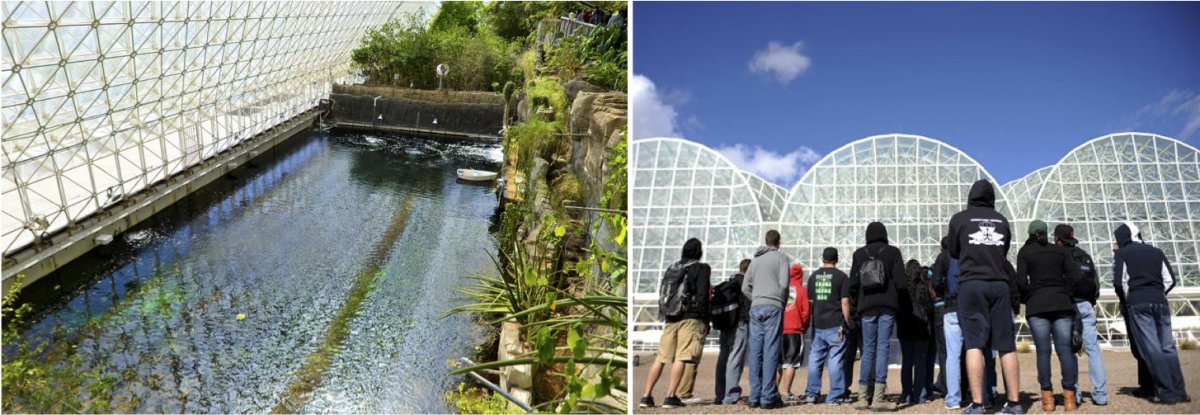
The Ocean area of Biosphere 2 in 2014 (left). Now a popular tourist attraction as well as research station, the Biosphere 2 facility offers regular tours (right).
During the first crew enclosure, a group of Yale forestry researchers defended the Biosphere 2 project against public ridicule, calling it “more than an experiment … it is a metaphor for the planet and our inhabitation of it.” Regardless of the reasons for its representation as a failure, the challenges of the first Biosphere 2 mission provided prescient analogs for Biosphere 1.
It also demonstrated the multilayered complexity of replicating an entire planet in microcosm, whether on Earth or elsewhere—including the less savory realities of maintaining a world built from scratch. Perhaps the most compelling conclusion: Our finely tuned, perfectly positioned, dynamic Planet Earth isn’t so easy for humans to replicate.
Current Analogs and Future Visions
The Biosphere 2 had been intended from the beginning as a for-profit endeavor, with income generated by tourism and patents—though only one major patent came of the project. Since then, nonprofits and state funded programs have taken up similar challenges in building planetary analog habitats.
A group from Fairbanks, Alaska called the International Space Exploration and Colonization Co. has slowly pursued construction of a closed ecological system like the Biosphere 2 called Mars Base 0. In the early 2000s, NASA started its own program of self-sustaining closed ecosystems called the BIOPlex, but funding dried up before construction began in earnest.
In 2014 a Chinese university-run project called Yuegong-1, or “Lunar Palace 1,” began its first Biosphere 2-type mission in which a crew of three spent 105 days inside a closed ecosystem, subsisting on grains, vegetables, and mealworms.
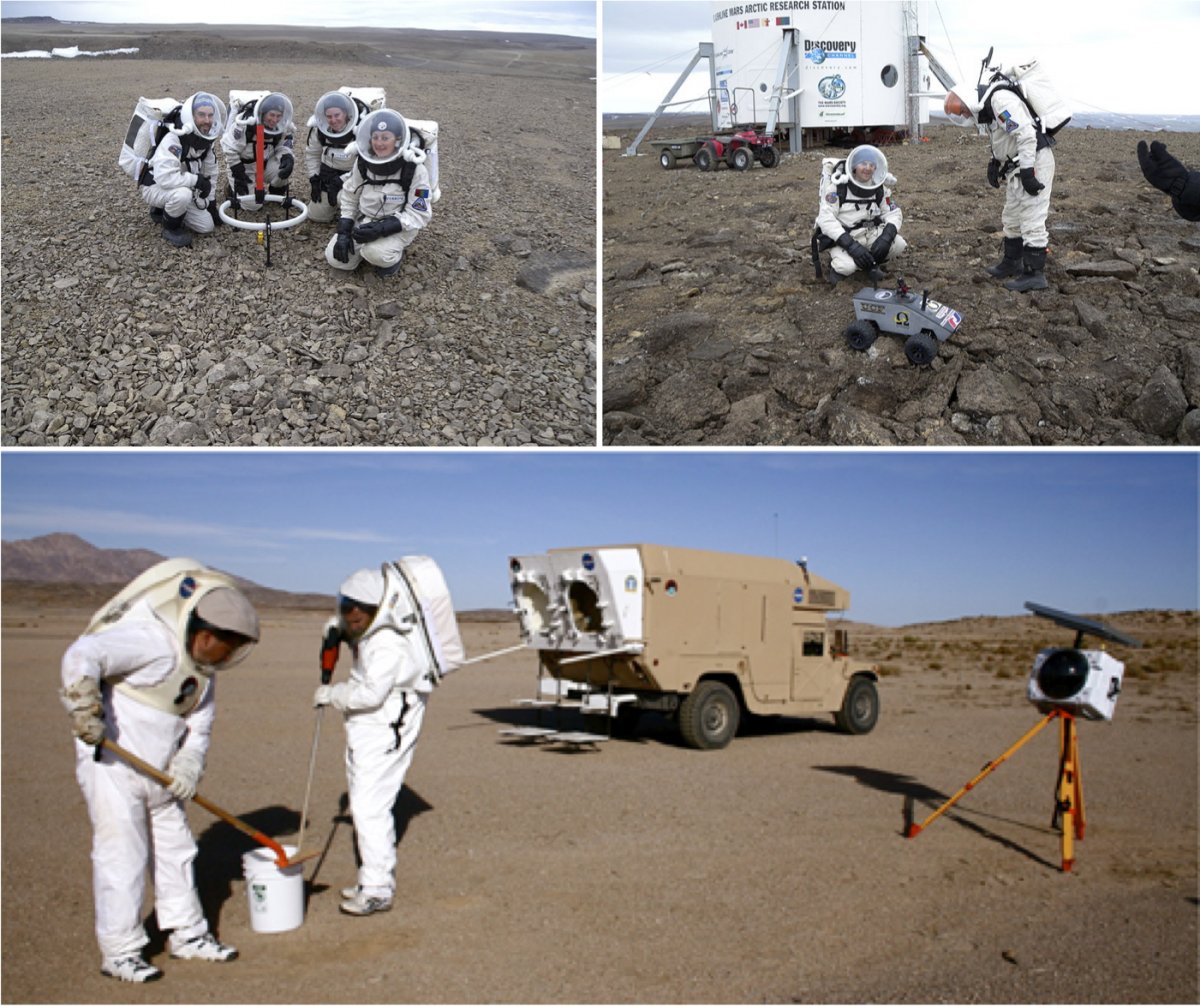
The Flashline Mars Arctic Research Station crew practice surveying with low frequency electromagnetic equipment on Devon Island in Canada in 2009 (left). The Flashline Mars Arctic Research Station with two crew members, the habitat, and rover in 2009 (right). NASA and researchers from the Mars Institute and SETI Institute conducting field tests in the Mojave Desert in 2011 (bottom).
For the most part, current planetary analogs with human inhabitants tend to operate small, spaceship-like habitats in natural places that resemble alien landscapes.
NASA has partnered with the nonprofit Mars Institute to run a yearly analog mission in a crater on the uninhabited Devon Island in the Canadian Arctic, and the nonprofit Mars Society owns and operates a Mars Desert Research Station (MDRS) in southern Utah. The University of Hawaii at Manoa operates the Hawai’i Space Exploration Analog and Simulation (HI-SEAS), in which crews of researchers conduct simulated missions in the Mars-like terrain of Mauna Loa.
The Chinese space program recently announced plans to build a “Mars village” in the Hongya (Red Cliff) region of Haixi Mongolian and Tibetan Autonomous Prefecture in north-west China. The site will host astronauts in training as well as tourists interested in experiencing all the adventure of Mars without the price tag, risk, and time investment of interplanetary travel.
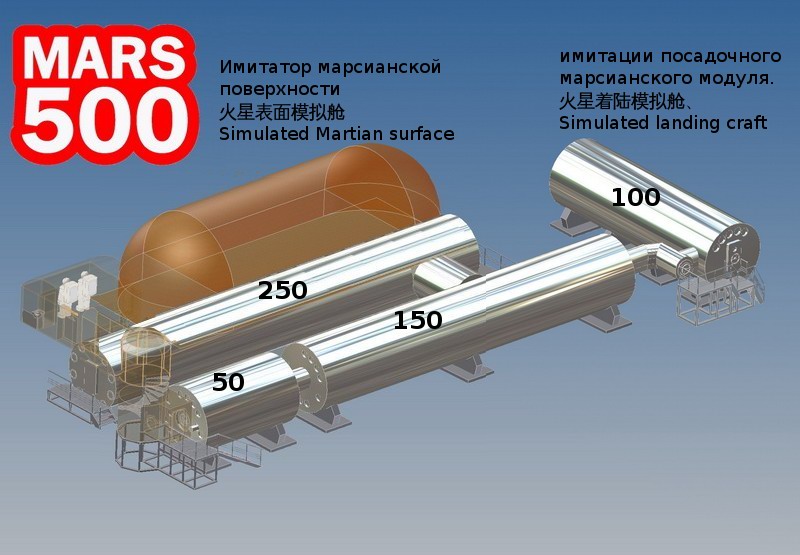
Other programs focus less on making Earth physically like Mars and more on replicating the social challenges of long missions.
The Russian-helmed MARS-500 installation encloses crews for long periods of time in order to test the psychological effects of long-term isolation. The NASA Extreme Environment Mission Operations (NEEMO) program confines crews, including seasoned astronauts like Peggy Whitson, Chris Hadfield, and Luca Parmitano, to an underwater habitat nine miles off the coast of Key Largo.
Nearly all these simulations designate requirements like wearing a space suit upon leaving the habitat, and enforcing time delays in communication with those outside the habitat to mimic the time it will take for signals to reach Earth on a real Mars mission.
Some missions yield experiments aimed towards normalizing the idea of life on other planets. A recent MDRS experiment sought to determine whether beer can be brewed on Mars (it can).

Crew members performing operations outside the NASA Extreme Environment Mission Operations (NEEMO) underwater laboratory (left). Crew members of NEEMO pose inside and outside their underwater habitat (right).
Beer might make Mars a more fun place to be, but what happens to beer on the other side of its consumption remains a thorny problem. With occasional exceptions, few of these proposed and in-progress planetary analog habitats expend significant effort grappling with the material realities of energy consumption, resource use, waste management, and environmental impact on the surrounding area once we get to Mars.
Plans put forth by Elon Musk and his ilk to transform the entire planet to resemble Earth suggest an even more daunting technical goal than creating small, life-sustaining cabins or greenhouses. Things could get messy quickly.
Increasingly, the reality of this messiness has gained attention alongside the orderly optimism of Mars boosters. Fiction of the past few years suggests that American culture may be coming to terms with the grittier side of space futures.
The 2011 novel The Martian and its 2015 film adaptation portray a seemingly near future in which America has repeatedly landed people on Mars. However, as the main character quickly learns, staying on Mars long term requires plenty of unpleasant mundanities. Even with magical (fictional) technologies such as radiation-blocking canvas keeping him alive, the protagonist finds that survival on an alien world requires less innovating and more tinkering, revising, and—quite literally—shoveling shit.

The poster for the 2015 film The Martian (left). The poster for the 2013 film Gravity (right).
In the 2013 film Gravity, humankind never even has a chance to reach Mars. A chain reaction of collisions destroys the entire satellite infrastructure within seconds, rendering low-Earth orbit an untraversable mess of speeding space junk. Although the main character survives through acts of luck and tinkering, the future from Gravity looks bleak—cut off from any potential escape routes to the rest of the cosmos, humanity must now live in the mess we’ve made on our planet.
If such a bleak future comes to pass, perhaps it would at least be an equitable one. Elon Musk’s proposed $200,000 price tag for a ticket to Mars still excludes the vast majority of humanity who cannot afford to get away should our planet cease to be able to support us.
If only the rich and well-connected make their way to Mars, what will that society look like? What parts of humanity, and of Earth, will be preserved and recreated in the new world, and at what cost to Mars? And what will happen to those left behind on a crowding, heating planet Earth?
Read more about the story of space exploration: The Soviets launch Sputnik, Mariner 9, the Moon Landing (PDF File), and Space Flight.
Peder Anker, From Bauhaus to Eco-House: A History of Ecological Design (2010).
Jay Barbree, Alan Shepard, and Deke Slayton. Moon Shot: The Inside Story of America’s Apollo Moon Landings (revised edition, 2011).
Scott Kelly, Endurance: A Year in Space, A Lifetime of Discovery (2017).
K. Maria D. Lane, Geographies of Mars: Seeing and Knowing the Red Planet (2010).
Roger Launius, ed., Exploring the Solar System: The History and Science of Planetary Exploration (2012).
W. Patrick McCray, The Visioneers: How a Group of Elite Scientists Pursued Space Colonies, Nanotechnologies, and a Limitless Future (2012).
Lisa Messeri, Placing Outer Space: An Earthly Ethnography of Other Worlds (2016).
Lisa Messeri, “Earth as Analog: The Interdisciplinary Debate and Astronaut Training that took Earth to the Moon,” Astropolitics 12 (2-3).
Rebecca Reider, Dreaming the Biosphere: The Theater of All Possibilities (2009).
Douglas A. Vakoch, ed. Astrobiology, History, and Society: Life Beyond Earth and the Impact of Discovery (2013).
Janet Vertesi, Seeing Like a Rover: How Robots, Teams, and Images Craft Knowledge of Mars (2015).
“Biosphere 2: Why an Eccentric Ecological Experiment Still Matters 25 Years Later,” http://edgeeffects.net/biosphere-2/
NASA.gov “About Analog Missions,” https://www.nasa.gov/analogs/what-are-analog-missions
http://money.cnn.com/2017/09/29/technology/future/elon-musk-spacex-mars-iac-conference/index.html
https://www.theguardian.com/world/2017/sep/07/china-mars-replica-space-tibet-plateau
https://www.space.com/38180-hi-seas-8-month-mars-simulation-ends.html

